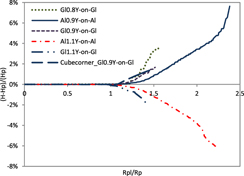Article contents
Volumes sampled for hardness and for modulus of elasticity during nanoindentation testing
Published online by Cambridge University Press: 07 June 2012
Abstract

In this article, the sizes of the volumes sampled by nanoindentation tests for hardness and modulus measurements are studied using finite element simulations. The zones of influence for hardness and modulus in single-phase systems are determined by modeling a hemispherical particle in a matrix, with properties close to those of each other, and monitoring the deviation of the measured values from those of the particle. It is found that, for hardness testing of elastic-perfectly plastic materials, the intrinsic hardness of the particle is measured as long as the plastic region is still within the particle, i.e., the contact radius is one half or less of the particle radius. Thus, in a hardness test of a single-phase material, all of the plastically deforming material, and only the plastically deforming material, contributes to the hardness measured. In contrast, the zone influencing the modulus is not restricted to a specific volume near the indenter. The modulus measured from the elastic response at the indentation point is dependent upon the entire specimen. A relationship is developed to describe the observed behavior of the measured modulus, that holds true for both sink-in and pile-up material behavior and for different indenter cone angles.
Information
- Type
- Articles
- Information
- Copyright
- Copyright © Materials Research Society 2012
References
REFERENCES
- 3
- Cited by

